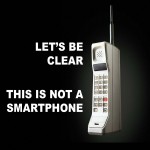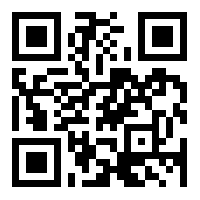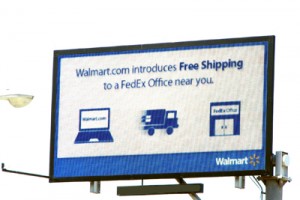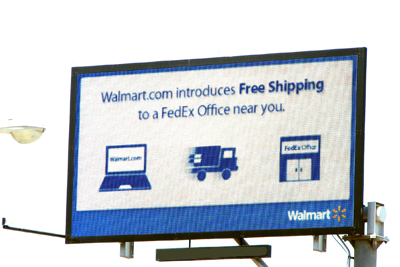ARTICLE HIGHLIGHTS:
- DOOH advertising in public venues reaches more Americans each month than online videos delivered by Facebook, Hulu, and YouTube combined
- The significance of people consuming more media out of the home, rather than in-home, has become important to advertisers
- The capital and operating costs of establishing and running networks have plummeted, substantially shortening the timeline to profitability
For many years now, as the leaves brown and the wind chills, people in the digital out-of-home (DOOH) industry have looked ahead and wondered if the next year will finally be the one that sees the sector get some genuine traction.
That tipping point year — when a new medium moves beyond tests and trials and becomes an accepted ingredient in a planning recipe — looks to finally be here. DOOH media adoption has followed the same path as online, cinema, and even social media. As new media networks mature, become easy to buy, produce consistent results, and deliver massive reach, they are rapidly adopted. There is too much tangible evidence to write it off to irrational optimism. It will happen for DOOH media in 2011, and in most respects, it’s already started.

Major advertisers are now investing millions in this category, which is also referred to as digital place-based advertising. That’s happening because the footprints of the largest networks have grown substantially through consolidation and expansion. The medium is also getting reliably and professionally measured and validated, and seasoned media pros are now actively selling in the space.
Stay informed. For more insights into the latest digital opportunities for brands, attend the iMedia Brand Summit, March 6-9.
Request your invitation today.
There remains a substantial Wild West element out there of small networks with oddball venues and media propositions, but the companies that are getting genuine attention have solid, validated offers that deliver the kind of targeting, breadth, efficiency, and value that brands now demand.
Here are the sorts of tipping point indicators we’re seeing:
On a macro level, the medium is effective. Seventy percent of U.S. residents 12 and older have seen a digital video display in a public place in the past month, and 52 percent recall seeing one in the past week. DOOH advertising in public venues, says Arbitron research, reaches more Americans each month than online videos delivered by Facebook, Hulu, and YouTube combined. DOOH spots are engaging viewers, with nearly half (47 percent) recalling specific ads they’ve seen on DOOH screens in the past month. And almost 20 percent of those who’ve seen an ad made an unplanned purchase because of it.
DOOH is being bought as a key element to most major advertising campaigns, and it’s getting recognized as a complement to broadcast, online, and even mobile and social media plans. Renewals are starting to represent more business than new customer wins for the larger DOOH networks. The top 10 advertisers in the U.S. have each spent more than $1 million in the past few months in DOOH.
Merger and acquisition activity has heated up. Our company has been very active in this area, and we are by no means alone. It’s driven in part by opportunity — there are lots of distressed properties in DOOH, as there are across most media right now. But M&A is also the fast-track to getting to the footprint and critical mass that’s now required to get on national plans. We estimate about 25 percent of the sector will be involved in M&A activity, from some angle, in 2011.
Advertisers and agencies are now talking about audience groups. DOOH media is planned and bought much the same way as broadcast, online, and print — by audience profile. The significance of people consuming more media out of the home, rather than in-home, has become important to advertisers. The right message delivered to the right consumer at the right time along the path to purchase — this is particularly important when targeting your audience.
The message is right. As an industry, DOOH is now demonstrating that it is relevant, consistent, predictable, and easy to buy. The message is also clear that this is a complementary medium that gives an overall plan more reach and substance, at tremendous value. It’s not intended to “replace” another medium.
Strong campaign results are becoming predictable and assumed. There is a steady growing body of evidence — fully measured and validated — showing DOOH moves the needle for such things as brand awareness and recall. From our own work at RMG, we know when Crest looked to increase purchase intent, DOOH raised it by 38 percent. When FedEx wanted to increase ad recall, DOOH delivered a 32 percent lift. When Nescafe wanted to motivate consumers to buy, DOOH triggered a 200 percent increase in purchase intent. These are the sorts of numbers being steadily produced across different networks, from niche vertical networks all the way up to mass networks in Walmart.
Top industry talent is moving into the category. Great media sales people are success-driven. The early adopters who’ve been involved for years in the sector did so for the challenge and the passion they had for this emerging medium. They travelled a rough, bumpy road. Now we’re seeing some of the most successful media sales pros come in because that road’s largely been paved for them, and the incentives are far more real.
Many players in this category are becoming profitable. The capital and operating costs of establishing and running networks have plummeted in recent years, substantially shortening the timeline to profitability. The lower operating costs and increased media spend in the industry have produced handsome results for many companies in our industry. Several of the top DOOH networks in the U.S. have hit profitability for the first time ever this year.
Major holding companies are making equity investments. Expect a major media holding company to enter the sector in some fashion in the coming year.
It takes about 10 years for any industry to mature, and that’s really about the length of time that DOOH networks have been in around in any tangible numbers. There is still much work to do, but we’re definitely now approaching that tipping point.
Garry McGuire is the CEO of Reach Media Group.
Follow iMedia Connection at @iMediaTweet.






